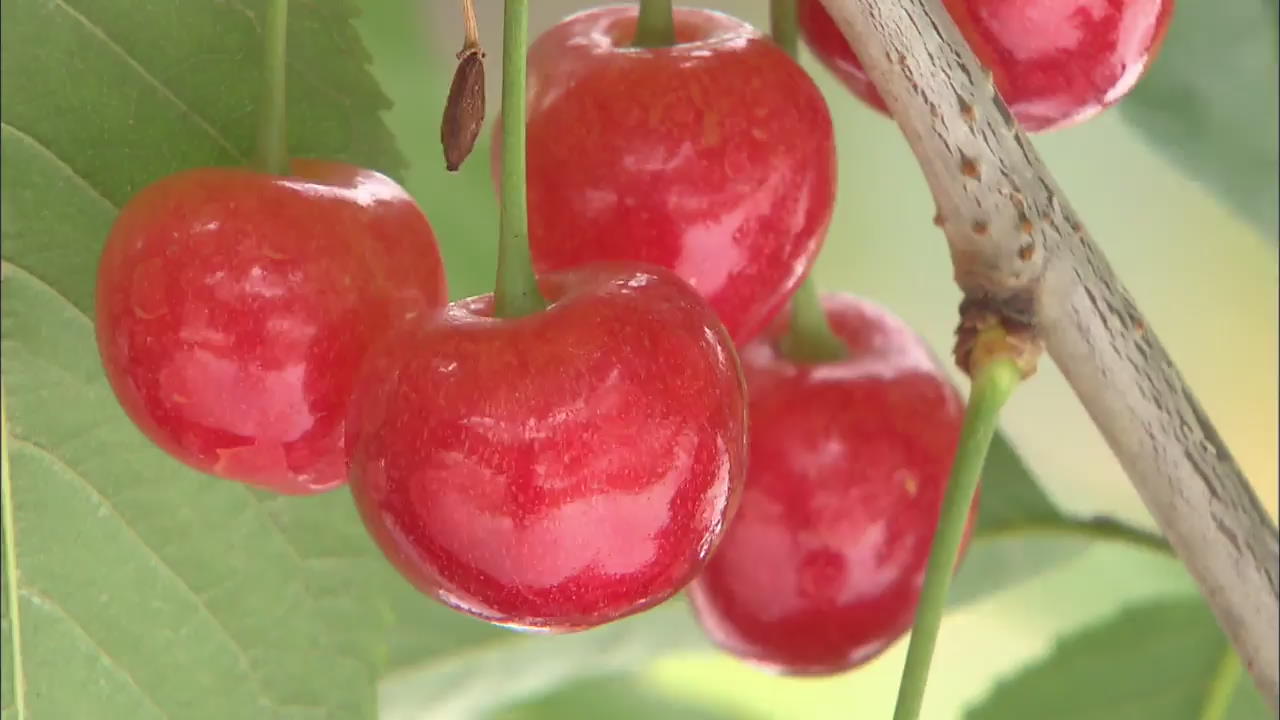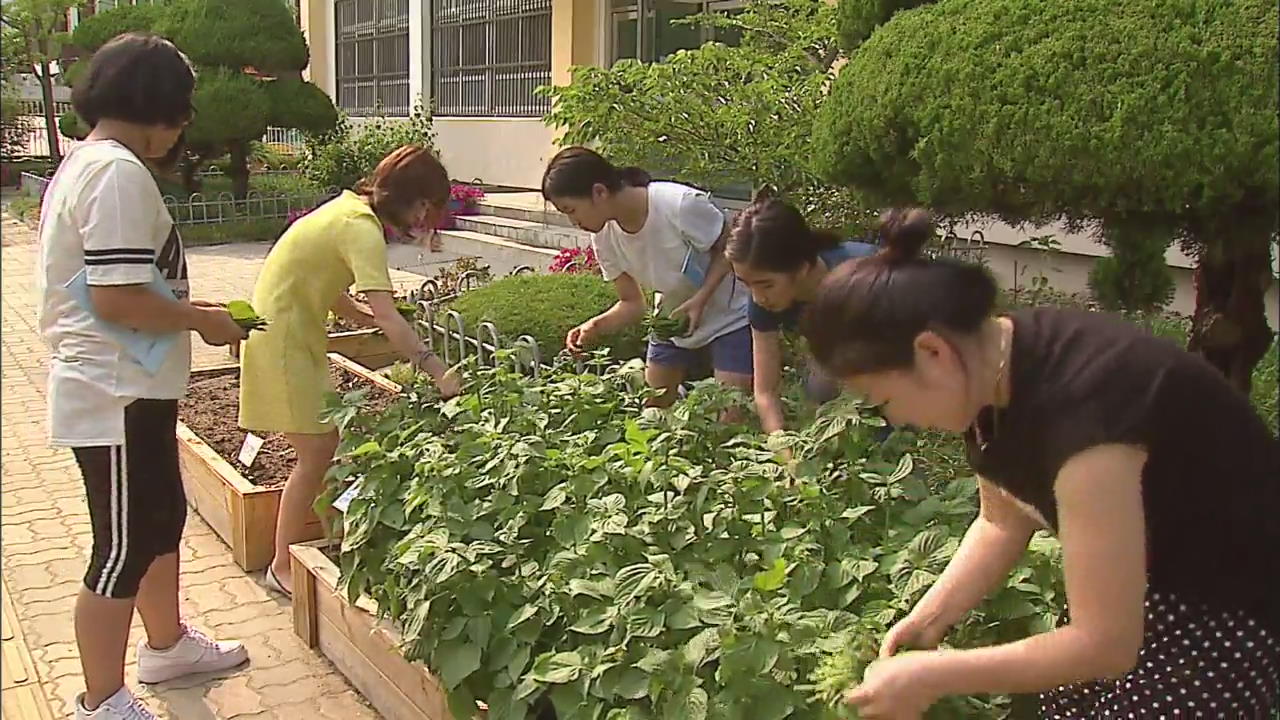Domestic Fruits
입력 2016.06.17 (14:06)
수정 2016.06.17 (14:38)
읽어주기 기능은 크롬기반의
브라우저에서만 사용하실 수 있습니다.
[Anchor Lead]
Mangoes and cherries, all of which were once imported from overseas, are now grown in local farms. Here is how home-grown foreign fruits are replacing the imports.
[Pkg]
Plump cherries hang heavy from the branches. It's been ten years since this farm converted to cherry crops due to a lack of profit from pear cultivation. The farmer is making more than 85,500 dollars in annual income since cherries are more lucrative and attract more buyers.
[Soundbite] Kim Ki-tae(Cherry Farmer) : "There are a lot more young customers, so farmers can sell 100% of their harvests."
This farm's blueberries are likewise sold as quickly as they can be harvested. Consumers' preference for fresh blueberries grown locally over frozen imported blueberries has led to increased profits for blueberry farmers. With Korea's implementation of free trade agreements, the country's foreign fruit imports grew 6% every year to reach 700,000 tons annually. These foreign fruits are replacing traditionally homegrown crops like apples and pears. However, the Korean agricultural industry started developing its own farming technologies, such as customizing foreign fruit trees for easier maintenance and cultivation. As a result, homegrown cherries have taken up 10% of domestic distribution, and blueberries account for 30%. Furthermore, people have started coming to the farms in search of safer food.
[Soundbite] Ji Wan-geun(Owner, Interactive Cherry Farm) : "Imported cherries are treated with preservatives, but ours are not. This makes them safer to eat."
The innovative farming technique of growing foreign fruit on domestic soil has turned a crisis into an opportunity.
Mangoes and cherries, all of which were once imported from overseas, are now grown in local farms. Here is how home-grown foreign fruits are replacing the imports.
[Pkg]
Plump cherries hang heavy from the branches. It's been ten years since this farm converted to cherry crops due to a lack of profit from pear cultivation. The farmer is making more than 85,500 dollars in annual income since cherries are more lucrative and attract more buyers.
[Soundbite] Kim Ki-tae(Cherry Farmer) : "There are a lot more young customers, so farmers can sell 100% of their harvests."
This farm's blueberries are likewise sold as quickly as they can be harvested. Consumers' preference for fresh blueberries grown locally over frozen imported blueberries has led to increased profits for blueberry farmers. With Korea's implementation of free trade agreements, the country's foreign fruit imports grew 6% every year to reach 700,000 tons annually. These foreign fruits are replacing traditionally homegrown crops like apples and pears. However, the Korean agricultural industry started developing its own farming technologies, such as customizing foreign fruit trees for easier maintenance and cultivation. As a result, homegrown cherries have taken up 10% of domestic distribution, and blueberries account for 30%. Furthermore, people have started coming to the farms in search of safer food.
[Soundbite] Ji Wan-geun(Owner, Interactive Cherry Farm) : "Imported cherries are treated with preservatives, but ours are not. This makes them safer to eat."
The innovative farming technique of growing foreign fruit on domestic soil has turned a crisis into an opportunity.
■ 제보하기
▷ 카카오톡 : 'KBS제보' 검색, 채널 추가
▷ 전화 : 02-781-1234, 4444
▷ 이메일 : kbs1234@kbs.co.kr
▷ 유튜브, 네이버, 카카오에서도 KBS뉴스를 구독해주세요!
- Domestic Fruits
-
- 입력 2016-06-17 14:08:11
- 수정2016-06-17 14:38:53

[Anchor Lead]
Mangoes and cherries, all of which were once imported from overseas, are now grown in local farms. Here is how home-grown foreign fruits are replacing the imports.
[Pkg]
Plump cherries hang heavy from the branches. It's been ten years since this farm converted to cherry crops due to a lack of profit from pear cultivation. The farmer is making more than 85,500 dollars in annual income since cherries are more lucrative and attract more buyers.
[Soundbite] Kim Ki-tae(Cherry Farmer) : "There are a lot more young customers, so farmers can sell 100% of their harvests."
This farm's blueberries are likewise sold as quickly as they can be harvested. Consumers' preference for fresh blueberries grown locally over frozen imported blueberries has led to increased profits for blueberry farmers. With Korea's implementation of free trade agreements, the country's foreign fruit imports grew 6% every year to reach 700,000 tons annually. These foreign fruits are replacing traditionally homegrown crops like apples and pears. However, the Korean agricultural industry started developing its own farming technologies, such as customizing foreign fruit trees for easier maintenance and cultivation. As a result, homegrown cherries have taken up 10% of domestic distribution, and blueberries account for 30%. Furthermore, people have started coming to the farms in search of safer food.
[Soundbite] Ji Wan-geun(Owner, Interactive Cherry Farm) : "Imported cherries are treated with preservatives, but ours are not. This makes them safer to eat."
The innovative farming technique of growing foreign fruit on domestic soil has turned a crisis into an opportunity.
Mangoes and cherries, all of which were once imported from overseas, are now grown in local farms. Here is how home-grown foreign fruits are replacing the imports.
[Pkg]
Plump cherries hang heavy from the branches. It's been ten years since this farm converted to cherry crops due to a lack of profit from pear cultivation. The farmer is making more than 85,500 dollars in annual income since cherries are more lucrative and attract more buyers.
[Soundbite] Kim Ki-tae(Cherry Farmer) : "There are a lot more young customers, so farmers can sell 100% of their harvests."
This farm's blueberries are likewise sold as quickly as they can be harvested. Consumers' preference for fresh blueberries grown locally over frozen imported blueberries has led to increased profits for blueberry farmers. With Korea's implementation of free trade agreements, the country's foreign fruit imports grew 6% every year to reach 700,000 tons annually. These foreign fruits are replacing traditionally homegrown crops like apples and pears. However, the Korean agricultural industry started developing its own farming technologies, such as customizing foreign fruit trees for easier maintenance and cultivation. As a result, homegrown cherries have taken up 10% of domestic distribution, and blueberries account for 30%. Furthermore, people have started coming to the farms in search of safer food.
[Soundbite] Ji Wan-geun(Owner, Interactive Cherry Farm) : "Imported cherries are treated with preservatives, but ours are not. This makes them safer to eat."
The innovative farming technique of growing foreign fruit on domestic soil has turned a crisis into an opportunity.
이 기사가 좋으셨다면
-
좋아요
0
-
응원해요
0
-
후속 원해요
0

















이 기사에 대한 의견을 남겨주세요.